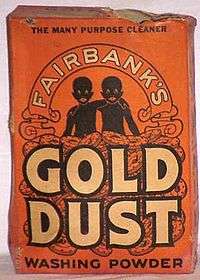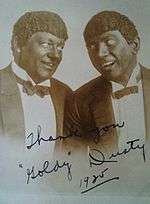Gold Dust Twins
The Gold Dust Twins, the trademark for Fairbank's Gold Dust Washing Powder products, appeared in printed media as early as 1892. "Goldie" and "Dusty", the original Gold Dust Twins, were often shown doing household chores together. In general use since, the term has had popular use as a nickname on several occasions. The sobriquet, "Gold Dust Twins," is often used to describe two talented individuals working closely together for a common goal, especially in sports.
As product mascots

Gold Dust Washing Powder
Gold Dust Washing Powder was an all-purpose cleaning agent first introduced in the late 1880s by the Nathaniel Kellogg Fairbank Soap Company based in New York City. Gold Dust was distributed in America by the Lever Brothers Company of Cambridge, Massachusetts. Its first regional success was in the midwestern United States. Gold Dust Washing Powders had been marketed nationally since the mid-1890s, becoming a top-selling national brand by 1903. Gold Dust products were eventually marketed internationally (by Unilever) in Canada and Great Britain. The product lines' bright orange labels all prominently featured the Gold Dust Twins.
The original "Gold Dust Twins"
The Gold Dust Twins, 'Goldie' and 'Dustie', were the 'faces' of the Fairbank's Gold Dust Washing product lines. The original (circa 1892) version of the twins was a standard drawing of two young African-American children cleaning up together in a washtub. On the original containers, they are simply pictured standing side-by-side behind a mound of gold coins, under an arch reading "Fairbank's" and over the "Gold Dust Washing Powder" text.
By 1900, the twins had been transformed into a cartoonish pair of caricature, bald, asexual black children shown wearing tutus emblazoned with the words "Gold" and "Dust". On product containers and in advertisements, they were often comically depicted, along with a huge stack of dishes in a washtub, with one twin cleaning, the other drying.[1] The twins became icons following a 1903 national marketing campaign, with the slogan "Let the Twins Do Your Work". They became an easily recognizable trademark found in many, if not most, U.S. homes during the first half of the twentieth century. The Gold Dust Twins were drawn by E.W. Kemble, a staff artist for the Chicago Daily Graphic'.[2]
The Twins were featured in print, billboard, specialty advertising and radio advertisements for over sixty years. "The Gold Dust Twins" was the name of a popular radio program which was first broadcast nationally in the US in 1929. Starring Harvey Hindemeyer and Earle Tuckerman as "Goldy" and "Dusty", respectively,[3][4] the show was sponsored by Lever Brothers and Gold Dust Washing Powder. An early example of product tie-ins, the Gold Dust's advertising jingle became the show's theme song.
The products (along with Goldie and Dustie) were phased out by the mid-1950s, as national sensibilities began to change.
The Twins appear in the 2004 release, C.S.A.: The Confederate States of America, an alternate-reality British documentary about American life after the Confederates had won the American Civil War. A recreation of a "Gold Dust Twins" commercial, featuring purposely outrageous racial stereotypes, is shown as part of the 'mockumentary.'
Use as a nickname
Historically, the "Gold Dust Twins" nickname has been used to describe two individuals working closely together for a common goal, including:

- Herman Sary and Leo Huck, two Catholic Carmelite brothers (circa 1898).[5]
- Tim Moore (later famous for his role of George "Kingfish" Stevens in the television version of Amos 'n' Andy), along with his stage-partners, Romeo Washburn and Cora Miskel, performed as part of the trio, "Cora and Her Gold Dust Twins," on the vaudeville circuit in the midwestern and the northeastern United States following the national popularization of the icons (early 1900s).[6]
- Benjamin V. Cohen and Thomas Corcoran, government (1930s).[7]
- Harold "Jug" McSpaden and Byron Nelson, golf (1930s and 1940s).[8]
- Hugo Black and Bibb Graves, Alabama "gold passport" carrying Klansmen.[9]
- Gus Mortson and Jim Thomson, Canadian hockey (1940s and early 1950s).[10]
- Royal Copeland and Joe Krol, Canadian football (1940s and early 1950s).[11]
- Lew Hoad and Ken Rosewall, tennis (1950s).
- Donny Anderson and Jim Grabowski, NFL football with the Green Bay Packers (1960s).[12]
- Fred Lynn and Jim Rice, Boston Red Sox baseball (1970s).[13]
There is a set of ham radio equipment made by the Collins Radio Company in the 1950s that was nicknamed the "Gold Dust Twins". The 75A-4 receiver and KWS-1 transmitter, together, cost over $2500 when new (equivalent to over $20,000 in 2012 dollars). Collins products at the time were considered 'top of the line'. Ham radio enthusiasts call the pair "The Gold Dust Twins," as they had not been affordable to most amateur radio enthusiasts when first introduced.[14]
References
- ↑ "Jumpin' Jim Crow: Southern Politics from Civil War to Civil Rights", by Jane Elizabeth Dailey, Glenda Elizabeth Gilmore, Bryant Simon; 2000, Princeton University Press, page 168
- ↑ E.W. Kemble
- ↑ Outside the Mainstream - Independent Race Talkies, Yiddish Talkies, Hollywood Goes Ethnic, Drag Comedy
- ↑ Excerpts from Broadcast History
- ↑ Rev. Anthony C Dressel, "Brother Herman Emil Sary, O.Carm. 1864-1911, The Sword, October 1940
- ↑ Tim Moore: The Gold Dust Twins
- ↑ The Morning Star; Wilimington, North Carolina; August 17, 1983, page 3B; Cohen obituary
- ↑ "Tales from the Bunker" Because of their consistent one-two finishes [during the war years], Nelson and McSpaden were together referred to as the "Gold Dust Twins".
- ↑ Hugo Black and the Judicial Revolution; by Gerald T. Dunne
- ↑ http://www.legendsofhockey.net/LegendsOfHockey/jsp/SearchPlayer.jsp?player=13788
- ↑ The Record.com; "Royal Copeland was part of the Argos' Gold Dust Twins", obituary article
- ↑ The Bryan Times; Saturday, September 2, 1972; Pg 7; Col. 1; Grabowski retirement article
- ↑ NESN; article: "Lynn Thrilled for Rice, His 'Gold Dust Twin' Hall of Famer"
- ↑ Amateur_Radio.com
External links
- www.theoldentimes.com
- www.chicagohistoryjournal.com
- otrrlibrary.org Behind the Mike Episode (10/27/1940) Harvey Hindemeyer and Earle Tuckerman (from 15:49-19:50)